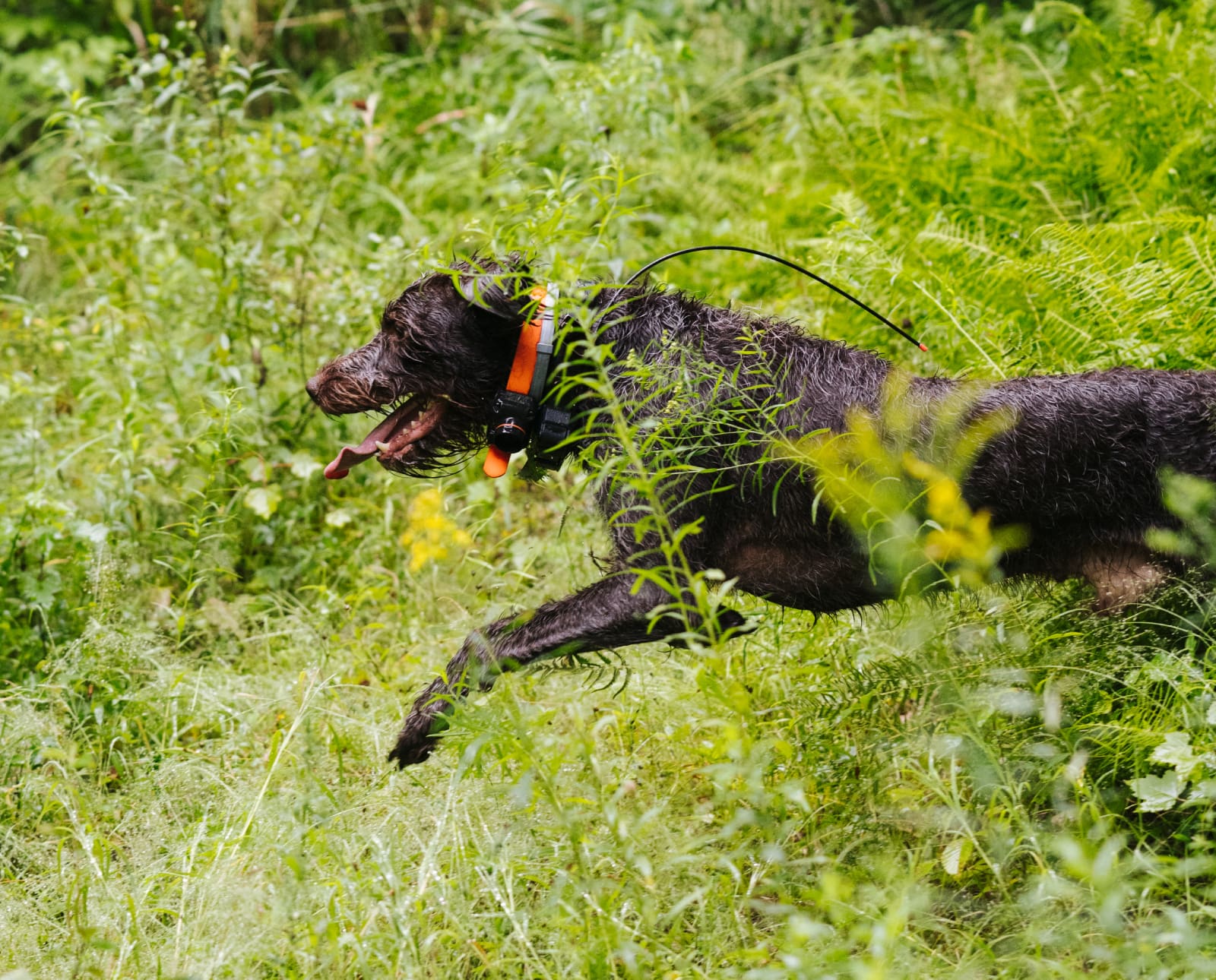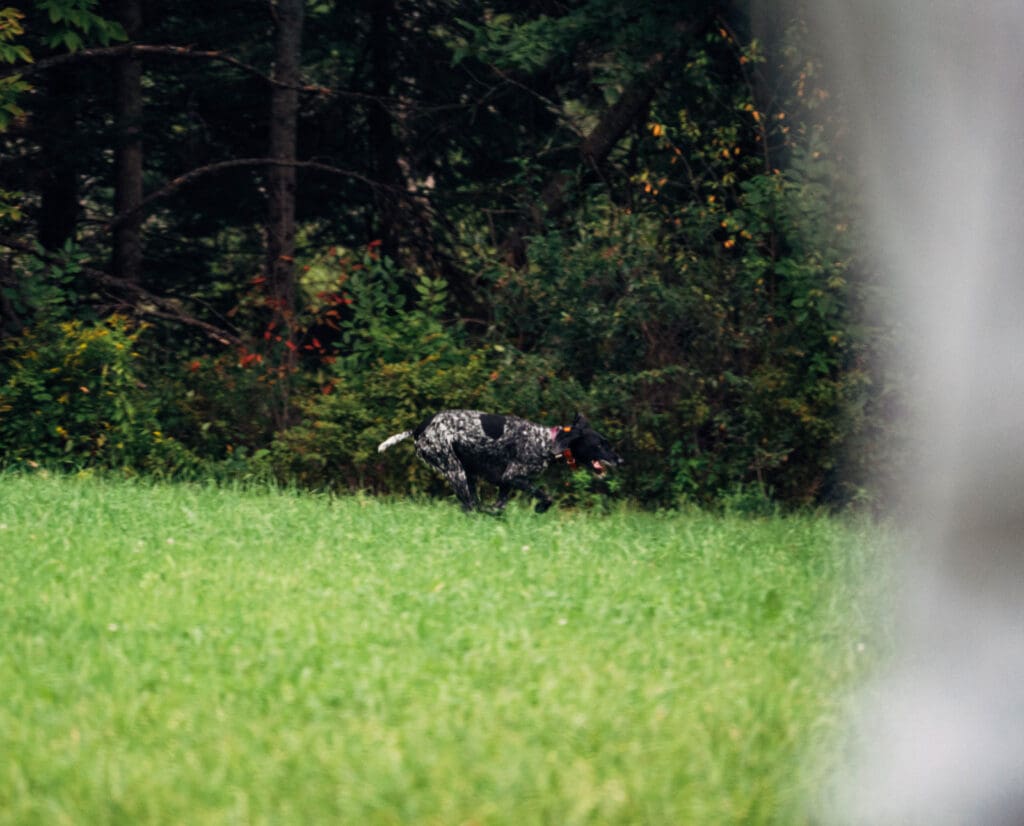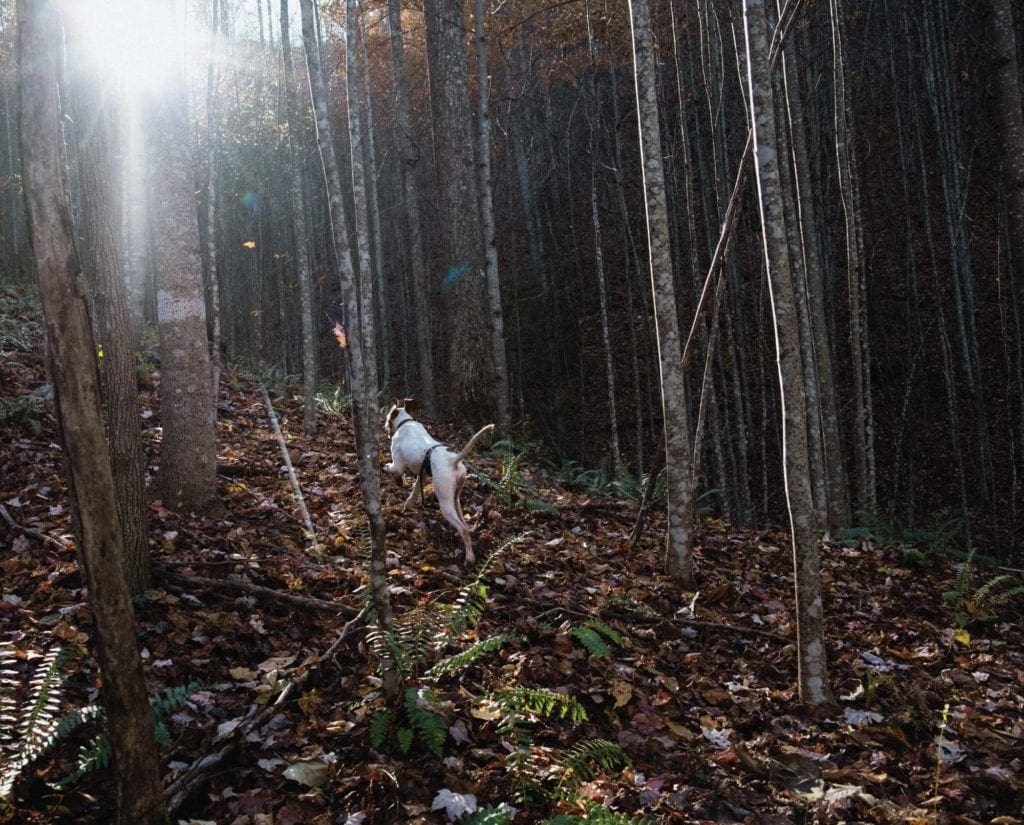Home » Hunting Dogs » Dog Conditioning – Physically Preparing Your Dog for the Rigor of Hunting Season
Dog Conditioning – Physically Preparing Your Dog for the Rigor of Hunting Season

Jason Carter is a NAVHDA judge, NADKC member, director of…
Best practices for physically conditioning your dog before hunting season.
A long day afield is mentally and physically strenuous for dogs. While reviewing this past hunting season, I noted a day-to-day depreciation of my dog’s energy on consecutive hunts. By the end of the week, they were shadows of themselves; lethargic, far less responsive, and making mistakes they normally didn’t make. I must also be cognizant of aging dogs’ physical limitations while exploring ways to maximize their potential.
Listen to more articles on Apple | Google | Spotify | Audible
Properly feeding, hydrating, and conditioning hunting dogs is of the utmost importance. During my reflections, I realized that I had failed to do all three. As a result, instead of being the energetic, bird-finding powerhouses I dreamed of, my dogs were shadows of themselves after a few days of hard work in the field. This was mostly due to improper feeding and watering schedules. However, conditioning was also a part of it.

Dog Conditioning Advice From The Experts
I talked with Eukanuba’s veterinary engagement manager, Dr. Jill Cline, Lynn Carradine, Royal Canin’s sporting dog specialist, and Dr. Arleigh Reynolds, DVM, a Senior Researcher and Senior Scientist in nutrition at Purina. They educated me on best practices for conditioning my hunting dogs prior to opening day and optimal feeding and hydration methods.
Dr. Reynolds explained that a properly fed and conditioned dog can take in and utilize roughly three times the amount of oxygen than a human. Conditioned dogs can run at a greater intensity for long periods of time without getting tired. These dogs don’t build up as much lactic acid and don’t get as hot. Properly conditioned dogs, or dogs with a high VO2 max, can maintain an aerobic pace for longer and burn far less glucose. Comparatively, out-of-shape dogs go anaerobic faster and burn through their glucose at a faster rate.
“Anaerobic exercise is any exercise that occurs in the absence of oxygen,” explains Dr. Reynolds. “Unlike aerobic exercise, which uses oxygen for energy, anaerobic exercise involves intense, powerful muscle contractions that require energy faster than oxygen can be supplied. Since an alternative energy source is needed, the body uses glycogen (a form of glucose) that is stored within muscles as fuel.”
To take a sedentary dog into the field and expect it to perform at a high level simply isn’t realistic and risks the well-being of the dog. “For weekend warrior hunters that haven’t done any conditioning with their dog and expect their dog to hunt all day, I say, ‘Dude, that’s not gonna happen. Your dog hasn’t been off the couch since last Sunday night!’” jokes Dr. Cline.
There is also a direct correlation between feeding and conditioning a dog and its performance in the field. By feeding your dog a high-fat diet, you support a higher density of mitochondria (the powerhouse organelle of a cell) in the muscle cells. Basically, you can increase your dog’s VO2 max by 50 percent simply by feeding it a high-fat diet.
This diet also improves endurance and power. For example, when you feed a 30/20 diet, the fat is already in the mitochondria within muscle cells. The dog’s body doesn’t have to pull from fat reserves, place it in the blood, and transport it to the muscles. The first 40 minutes of exercise are already there, ready to go.
Also worth noting is that dogs who can remain aerobic tolerate greater ambient temperatures and recover faster. On the other end of the spectrum, poorly conditioned dogs tend to overheat quickly. Hyperthermia is a dangerous and potentially fatal condition for dogs. This occurs when the dog’s body temperature remains elevated for a long period of time. Dr. Reynold explains, “Dogs up around 106-107 degrees for more than a couple minutes is a concern. Dogs that drop below 104 in a minute are doing okay. Sadly, dogs that overheat can permanently blow their thermostat and can never thermoregulate well again.”
To quickly drop body temperature, it’s suggested to carry isopropyl alcohol to help dissipate heat, cool water to clear the membranes in the mouth so the dog can cool itself, and replenish the lost water in the dog to help it cool internally.
In speaking with Lynn Carradine, she plans her conditioning and feeding specifically toward what the dog will be experiencing for a hunt or in dog training.
The FITT Conditioning Principal
Within moments of meeting Lynn, I knew I was talking to an experienced hunter and sporting dog enthusiast. Lynn’s passion for hog hunting and upland bird hunting was infectious. We were already sharing stories and laughs about her Gordon Setter and hog dog as if we were long-time friends sitting around the campfire. The thing that struck a chord with me the most was the science she relied upon. All her information was science-based, breed-specific, and supported by evidence and personal hunting experiences.
She explained the FITT conditioning principle to me. It looks like this:
- Frequency: How often the dog is conditioned.
- Intensity: The intensity of the workout.
- Type: The type of movements the dog will experience.
- Time: The amount of time the dog is going to be moved.
- Rest: The amount of time the dog will have to recover.
When Lynn sends her Gordon Setter away to be trained, she gears her conditioning towards hill work. These workouts mimic the long movements that the dog will experience on the pro trainer’s 1,000-acre runs.
Conditioning will start easy and increase in intensity and duration every day. The best way to improve VO2 max is long, slow distance training, which reduces the chances of injury or heat stress. Lynn will also provide interval training through high-intensity work, usually via retrieving in her pond, which provides low-impact, low-speed resistance training with moderate difficulty.
“I push training to the extreme. In my mind, a dog should be doing more in training than they are going to do in the season,” says Carradine.
For me, hunting season is primarily spent trudging through northeastern brambles. This habitat requires my dogs to be trim and nimble for the day-long agility course-type hunting. Roading and field runs are great. However, my dogs will be spending their days short-hopping trees and making quick changes in directions. To prevent injuries, they need to have strong supportive muscles and ligaments for this type of movement. To facilitate the strengthening of these muscles, I need to train them in the most contextually appropriate environments.
Realistically, my conditioning program could never mimic a week of hunting in the north country. By early fall, my dogs are at their peak condition for what I can provide. With that said, expecting them to put in full days for a week of hunting without any depreciation of performance wouldn’t be fair. This risks injury and health issues, not including mental sharpness and physical performance. Though they’d be willing to try, it’s my job to keep them safe and gauge when they need a break, especially during the early season.
Once hunting season opens, I no longer formally condition my dogs. I try to get out daily for three or four hours during the work week and run full days on the weekend for most of the season. For some, conditioning may continue into hunting season if they are weekend warriors or constrained to just a few hunts a year. Specified conditioning towards the type of hunting terrain is exceptionally important for these dogs.
A dog conditioned for big runs in the open prairie with relatively flat terrain may not fare as well in the mountains chasing chukar or the thick brambles of the north country chasing ruffed grouse and woodcock. When the training grounds don’t match the hunting conditions, it’s like training for a marathon but running a Tough Mudder instead. The body will eventually adjust, but not before shortened or lost days in the field due to fatigue or injury.

How Feeding Plays Into Conditioning
I’ve found that dogs that are used to performing while hot, tired, and stressed are better equipped to handle less-than-ideal hunting days. The last thing I want to do is call a hunt short because I did not properly prepare my dogs. I’ve learned that this all starts by fueling your dog with the highest-quality performance fuel possible, designed for your breed of dog and the type of hunting they will be doing.
To know if your dog is at a healthy weight, run your hand down its spine. You should feel vertebrae, but they shouldn’t be poking up, and you shouldn’t have to dig down to feel them. Extra weight on dogs causes heat and orthopedic issues. For example, overweight puppies are three times more likely to develop hip dysplasia.
Studies have shown that dogs that were free-fed showed three-fifths more evidence of hip dysplasia, whereas restricted-fed dogs showed only one-fifth. The hip dysplasia gene expressed itself differently simply by how the dogs were fed. Lean pups reach the same size with a far greater chance of developing healthy bones and joints. However, emaciated dogs don’t have the energy reserves needed for long, high-intensity work such as hunting.
If you need to help your dog put on weight, outside of feeding quality dog food at the proper time, Royal Canin offers a calorically high canned supplement called Water Bait. It’s both hydrating and filling. Also, adding Omega-3 fatty acid supplements to your dog’s diet is good for brain growth and functioning in both puppies and senior dogs.
By reclaiming my dogs’ feeding and physical conditioning, I expect to be paid back with stronger athletes who are fueled by the best. Long and productive days in the field next season are guaranteed. The years of love and dedication my dogs provide me compel me to continually educate myself, ensuring my dogs receive the best practices of conditioning, hydrating, and fueling I can provide. Hopefully, my efforts will create happier, healthier dogs for many years to come.
Jason Carter is a NAVHDA judge, NADKC member, director of youth development, secretary of NAVHDA’s youth committee, clinic leader and trainer at Merrymeeting Kennels. He has been around versatile hunting dogs his entire life, literally! Born into the Carter family and Merrymeeting Kennels, he attended his first NAVHDA test in Bowdoinham, Maine, when he was just a year of age. Jason successfully trains, tests and breeds Deutsch Kurzhaars in both the NAVHDA and NADKC testing systems. Through his work at the kennel, Jason has had the opportunity to develop pointers, flushers and retrievers over the years. When October arrives he can be found with family and friends hunting throughout New England.



